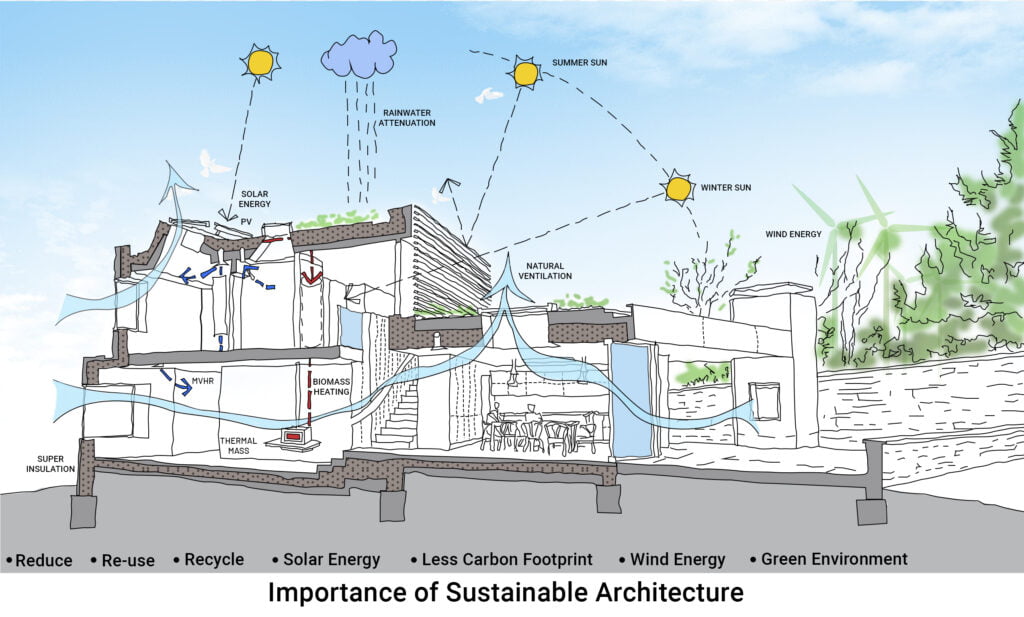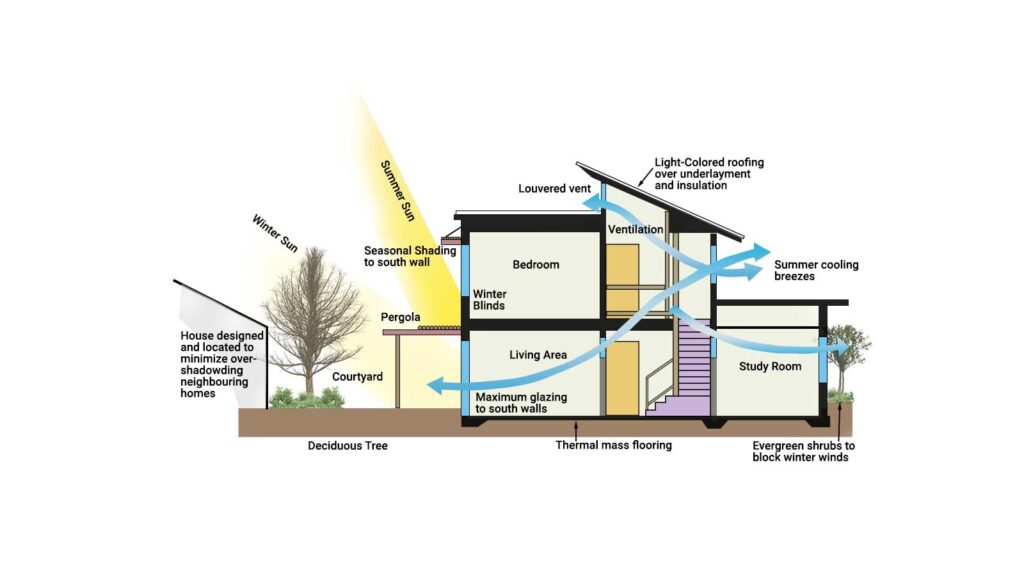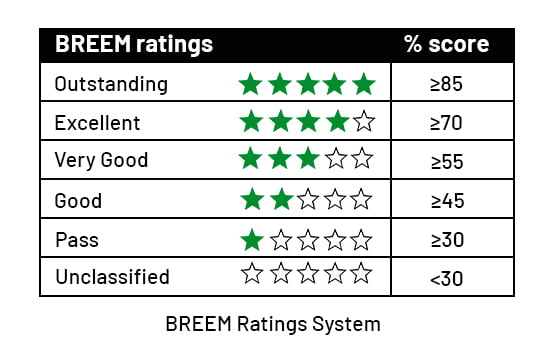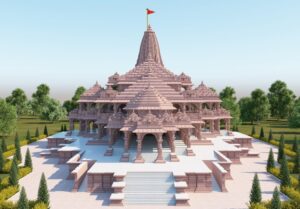What is sustainable architecture and why is it important?
Green architecture, climate-responsive architecture, and environmental architecture are other terms for sustainable architecture. It is a type of architecture that limits the use of material, design, and space in any way that has an impact on the environment. It is an eco-friendly approach to designing a building by introducing modern techniques and combining them with traditional methods. This kind of approach should be considered in designing the space, the construction process, the selection of materials, the use of natural resources, and other vital considerations that create a beautiful built environment in the natural landscape. [3] In the planning of a built environment, it always strives to conserve energy and the environment. [2]
Why it is important:
While the population is increasing widely in this world, we are left with limited resources. We don’t have any other option except to accept this kind of architecture. And we also don’t have any other earth. Designing a building that is energy efficient and has less impact on the environment is the ultimate goal of sustainable architecture. We architects should take some steps and design buildings that use active and passive strategies to reduce energy consumption while also making the building more comfortable and healthier for the users. [2]
Over the years, buildings and construction works have accounted for more than 35% of global energy use and approximately 40% of CO2 emissions. It was stated in the UN Environment Global Status Report 2017. The drop in these numbers was seen after 2010, when people became aware of the term sustainability, but still, there is a long way to go, and we have to continue like this to make it more impactful. [6]

Historical Evolution of Sustainable Design Principles
The historical evolution of sustainable architecture is a fascinating journey that has developed and emerged by combining modern techniques with ancient building techniques. The modern consciousness about sustainable architecture has made us aware and more responsible to create regenerative design solutions, but it has been with us for the past 50 years. Here is a brief history of historical evolution:
Indigenous and Vernacular Architecture (Pre-Industrial Era):
- Many communities around the world developed different building techniques that were based on the local materials, climate, and culture.
- Vernacular architecture reflects the use of local materials and techniques. In India, mostly every state has its own vernacular architecture, and the reflection of it can be seen in various buildings out there.
The green building movement and adoption of organic architecture (Early 20th Century)
- In the early 20th century, pioneering urban planner Ebenezer Howard introduced the garden city movement, which advocated a city plan combined with access to nature. The idea introduced the importance of green space, efficient land use, and minimizing the environmental impact.
- Architect Frank Lloyd Wright introduced the concept of organic architecture, which brought humanity closer to nature. Falling water over a waterfall is his greatest example.
- The green building movement made everyone around the world aware of the importance of sustainable building practices, and certification systems like LEED encouraged others to focus on energy efficiency, water conservation, and indoor air quality.
Introduction to Biophilia and Biomimicry (2000–present)
To read the main article on this topic, click here: Biophilia and Biomimicry
- Biophilia means bringing nature into your building space, and with the awareness and need for it, people understood the importance of it.
- Biomimicry means taking inspiration from nature’s design and processing it to make a sustainable solution. It encourages people to emulate natural systems and leads to the innovation of architecture, materials, and designs.
Adoption of regenerative design (Present)
- Regenerative design goes beyond sustainability by seeking to restore and renew ecosystems.
- It aims to create designs and systems that actively contribute to environmental and social well-being.
The Principles of Sustainable Architecture
The principles of sustainable architecture contain lots of considerations. Here are the key principles of sustainable architecture:
Energy-Efficient Design Strategies
Today, we are wasting more energy in buildings as compared to other things. This needs to be controlled because it is a significant portion of global energy use. Sustainable architecture can address these issues with different strategies, like:
Proper building orientation
The orientation of the building and house plays a crucial role in minimizing energy demands. Orientations help maximize natural light, manage daylighting and natural air circulation, and minimize heat gain or loss.
High-performance insulation
Using modern insulation materials reduces not just the building’s heating and cooling needs but also its power costs and reliance on wood for heating.
Energy-efficient windows
Installing windows that have E-coating or low-emissivity coatings and multiple panes helps improve the insulation inside the house. E-coating is generally a thin layer of coating over the glass, which prevents certain wavelengths of light from passing through the glass to reduce the impact of harsh light. The coatings don’t distort the opaque nature of the glass.
Water Conservation in Building Design
We all know that we are left with a limited amount of water; approximately 3% of water is fresh on earth. Accounting for water conservation in building design is crucial for sustainable architecture.
Low-flow fixtures
Going with water-saving fixtures helps reduce the consumption of daily water requirements. In Delhi, approximately 135 litres of water are needed per person. Wasting the water is unnecessary and will increase water demand and daily consumption.
Greywater Recycling
Reducing, reusing, and recycling, These three RRRs can save a lot of time. Treating and reusing the grey water for non-portable purposes can help a lot.
Rainwater Harvesting
Many Indian states now have strong rainwater collection guidelines, which we must observe for the sake of ourselves and the mother earth. We can save a lot of water by establishing a rainwater harvesting system and using it for our purposes. Water collected can be used for toilet flushing, mopping, car washing, irrigation, and other purposes. Before using rainwater, make certain that the system is built to filter and purify the water in accordance with local rules and health requirements.
Storm water management is also a best practice for conserving water by designing bioswales or drainage swales, rain gardens, and detention basins. After purifying and treating them, we can use them for non-portable purposes.
Sustainable Materials and Building Techniques
There are a number of sustainable building materials available on the market; some of the locally known materials are: bamboo, wood, concrete, steel, brick, plastic, cork, adobe, rammed earth, natural stone, etc. These are easily available on the market, and you guys must have listened to these materials. But there are a lot of other materials that are used in the world for construction, like cross-laminated timber, solar glass, pollution-absorbing bricks, cigarette butt bricks, bioplastics, aluminum foam, hempcrete, lumber, straw bale, engineered wood, vermiculite, flax linen, sisal, cseb (compressed stabilized earthen brick), seagrass, etc. They are used for various construction projects and have different advantages. I hope in the future there will be more additions to these materials, as they carry lots of advantages and have lots of benefits.
Energy-efficient construction practices need the use of sustainable resources. These strategies seek to reduce the environmental impact of buildings at every stage of their lifecycle, from raw material extraction and manufacturing to construction, operation, and eventual demolition or rehabilitation.
Building techniques like prefabrication and 3D printing can pace the construction and minimize waste. On-site construction results in the waste of materials and also generates pollution. By constructing off-site, we can reduce the waste and prevent pollution as well.
Natural Light and Ventilation
To read the main article on this topic, click here: Daylighting and Ventilation.
A good site analysis can help you understand your site, and you will be clear about the opening, which will not just enhance the beauty of your site but also make you comfortable in various aspects. Natural ventilation, or cross ventilation, not only reduces electricity usage but also enhances the well-being of occupants. Placing openings or windows in the right place ensures good ventilation and daylight inside the space. It makes the occupants comfortable, cools the indoor environment, improves the air quality, etc. [1]

To get these kinds of benefits from the nature orientation of your house or building, it needs to be perfect. Orienting the building on the north-south axis can give you good daylighting with less solar heat gain. [4] Large windows, skylights, arches, jalis, and atriums are some common design elements for better natural light and ventilation.
Biophilic Design in Sustainable Architecture
Biophilic design does not just connect or bring nature into your space; it also helps create a built environment inside your house. It adds more beautification to your house, brings positivity, reduces stress, improves your mental health, cools the air, removes impurities, blocks the harsh sunlight, and reduces solar heat gain by shading the house. Adding features like indoor plants, natural materials, access to the outdoor world, a terrace garden, a green balcony, etc. will make the house more attached to nature.
Future Trends and Innovations
The field of architecture is continuously evolving by the introduction of modern technology, trends, automation, sensors, and innovations. Here are some of the examples from it:-
Net-Zero Energy Buildings
Net-zero-energy buildings, or zero-energy buildings, are the most energy-efficient buildings with low carbon emissions. These types of buildings are dependent on renewable sources of energy to meet their energy demands. Most of the energy in buildings is used for light and air demands. This energy can be generated by solar panels, biogas, hydropower, etc. These systems are more reliable, energy efficient, less costly, and eco-friendly.
3D Printing in Sustainable Construction
3D printing is the greatest example of modern construction technology. With this technology now a days houses are build in weeks only before this we have to wait for months. Recently, an alumni of IIT Madras founded a startup that uses 3D printing to build houses. As of now, some houses and commercial spaces are built using this technology. With the advancement of technology, 3D printing can speed up construction and reduce material waste while also producing precise buildings.
Certifications and Standards
With the introduction of certification and standards by the various organizations, people understood the necessity of sustainable architecture, and architects are designing various marvelous structures throughout the world that are making building lifestyle more comfortable and energy efficient. Below are some of the certification organizations discussed:
IGBC Green New Buildings Rating System
The IGBC Green New Buildings rating system addresses the most important national priorities which include water conservation, handling waste, energy efficiency, reduced use of fossil fuels, lesser dependence on the usage of virgin materials and the health and well-being of occupants. The threshold criteria for certification levels are as under:
| Certification Level | Owner-Occupied Buildings | Tenant-Occupied Buildings | Recognition |
| Certified | 40-49 | 40-49 | Best Practices |
| Silver | 50-59 | 50-59 | Outstanding Performance |
| Gold | 60-74 | 60-74 | National Excellence |
| Platinum | 75-100 | 75-100 | Global Leadership |
To read more about the IGBC rating system, procedure, and criteria, visit their website or click here
LEED rating system by U.S Green Building Council
LEED (Leadership in Energy and Environmental Design) is a rating system governed by the US Green Building Council in the late 1990s. The certification is given when the building is proven to be sustainable and efficient. The certification is given on the basis of a points system; more sustainable means higher points.
- 40-49 points – Certified
- 50-59 points – Silver
- 60-79 points – Gold
- 80+ points – Platinum
To read more about the LEED rating system, procedure, and criteria, visit their website or click here
BREEAM rating system
As India and the U.S. have their rating systems, the UK has BREEAM. Just like other BREEM (Building Research Establishment Environmental Assessment Method), it also validates and gives certification for the sustainability of the buildings. The factors evaluated include land use, energy, water, pollution, transport, materials, and well-being.
The ratings are given as follows:

To read more about the BREEM rating system, procedure, and criteria, visit their website or click here
Benefits and Challenges of Sustainable Architecture
Benefits
- Energy consumption from renewable resources without harming the climate and maintaining ecological balance is the main advantage of sustainable architecture.
- It brings benefits like lower operational costs due to self-sustaining energy generation.
- The improved designs also help lower energy consumption.
- Having a better environment can promote better health, consequently increasing productivity.
- Accepting such green practices by example This encourages other builders, companies, and even individuals to switch to sustainable options, joining hands to save our planet Earth! [5]
- Biophilic design also establishes a much-needed connection between nature and humans while promoting natural diversity within the design project. [1]
Challenges
- Sustainable architecture is initially a more expensive practice; architects need to be aware of every material and technique to cut down on the cost of building a sustainable building.
- Sustainability is a practice that can’t be achieved in a year or two. This practice demands constant study of this type of architecture and lots of effort and knowledge to balance aesthetics, sustainability, and making it visually appealing.
- With the increasing frequency of extreme weather events, sustainable architecture must also focus on resilience, ensuring that buildings can withstand and recover from natural disasters.
A case study of a sustainable and net-zero building will be added in the coming days.










